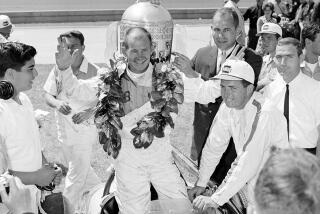A Collision With the Past : Paralyzed Regazzoni Returns as Street Racer to Site of Tragedy
ROSAMOND, Calif. â The buzzing and squealing of a man chasing his past echo interminably across the high desert. Then suddenly, silence.
The modified Toyota Celica, alone amid the scrub brush and tumbleweeds of a scarred asphalt track, rolls to a wall.
The car stops. Driver Clay Regazzoni raises his hands. The noise has returned and this time it is him, shouting in Italian.
It is about a belt. He needs a belt.
Not a belt for the fan, or alternator, or power steering.
He needs a belt for his left leg.
He needs it to keep the useless limb from flopping on his equally useless right leg.
He canât move the leg back with his hands, because his hands do more than steer and shift.
His hands work the gas. And the brakes. And the clutch.
The rules for this once-great driver are different now.
But his will is not.
In 1980, after winning the inaugural event four years earlier, Regazzoni was in an accident in the Long Beach Grand Prix that left him paralyzed from the waist down.
In two weeks, Regazzoni will return to Long Beach for the first time since then to prove that legs were the only things lost.
In what could be the first instance in racing history of a paraplegic driver racing again on the site of his paralyzing crash, Regazzoni will compete with 16 others April 16 in the Toyota Pro-Celebrity race.
Usually such events serve only as an entertaining preview to the main race--watch your favorite sitcom star spin out at 110 m.p.h.
But this yearâs pro-am, one day before the annual Indy car race at the same location, contains as many twists as the course.
Watch Regazzoni drive west down Shoreline Drive as he was doing on the 51st lap in 1980.
Watch him pass the spot where his brake pedal fell off.
Watch him drive past the dead-end escape road where his car hit stacks of old tires, then a concrete wall, at 160 m.p.h.
Watch him drive past rescue workers, who took 22 minutes to cut him from wreckage that pinned his knees to his helmet.
Watch him chat with Chuck Jones, the Tustin businessman who was co-owner of the car that Regazzoni crashed. A man who will forever wonder if he shouldnât have used a different welding technique on that brake pedal.
Watch him see other old friends. Watch him revisit every old nightmare.
But donât expect to see Regazzoni sweat.
Earlier this week while practicing here at Willow Springs in Rosamond, Regazzoni was shown a picture of the smoldering rubble from 1980.
He laughed. And he laughed. And he laughed.
Two co-workers saw this and shivered.
âI am cold, no?â Regazzoni said. âI am cold.â
*
Regazzoni was on the verge of racing past several other Toyotas driven by celebrities during training this week when suddenly he backed off.
âHmmm, guess he just stepped on the brake,â a Toyota official said.
The man paused before realizing his error.
âOh, uh, I mean, I guess he just used the brake,â he said.
As stunning as any driving Regazzoni does these days is the sight of him climbing out of his car and into a wheelchair.
At 54, this Swiss-Italian with a substantial mustache and temper not only still drives with the speed and smarts of a former Formula One champion, but he acts the part.
âYou want my life story? I give it to you two minutes!â he screamed at a reporter last week. âI do what I always did! I just do it differently!â
Willow Springs officials made him stop practice briefly last week, and not because he was endangering fellow racers.
It was because he was the only one on the course without a helmet.
As soon as the other racers finished, Regazzoni removed the helmet again.
âIn these (roofed) cars, what do you need it for?â he asked.
His participation in the pro-celebrity race is indeed akin to Michael Jordan returning to basketball action in a charity game against sheriffâs deputies.
But as Jones has lately reminded him, one rule will guide Regazzoniâs return to Long Beach, even in a street stock car.
No matter how fast he runs, acceptance will come slowly.
âRight now, we just need to show people that itâs OK, that challenged drivers can do it without their legs,â said Jones, searching for sponsors for a disabled team including Regazzoni and local disabled driver Mitch Payton. âPeople need to realize that once on the course, all drivers are the same. They are all just helmets.â
Regazzoni, who began driving within a year of his accident, has raced a variety of cars throughout Europe during the last 15 years, including in the Paris-Dakar rally.
He has also founded a disabled driving school in Rome. His influence with the government there has helped ease restrictions on the issuance of drivers licenses to disabled Italians.
But with the advancement of hand-control technology, last year he felt confident enough to return to his first love, street racing. In October, he drove a street stock in an International Motor Sports Assn. race at Sebring, Fla.
Already, Payton had won three such races and the barriers were beginning to fall.
Regazzoniâs car didnât finish, but he and Jones were confident enough to begin thinking that with a little publicity, money could be raised for a full-season attempt.
Chris Pook, president of the Grand Prix Assn. of Long Beach, says he talked to Jones and began thinking the same thing.
âAs macabre as it may sound, I thought, âIf he needs publicity, he will get an incredible amount for returning here for the first time,â â Pook said. âThe first winner competing in our 20th anniversary. It is an incredible story.â
According to Jones, however, it was a story that Pook initially viewed with discomfort.
âI called Chris and said, âWould you like to Clay to drive?â â Jones recalled. âHe was like, âOh, yeah . . . but can he?â â
Pookâs recollection of the story differs.
âI am the one who asked Clay to come back,â he said.
Whatever, Regazzoni is here, and there will be questions.
How does he drive?
He steers and shifts gears with his right hand--the clutch is a touch-sensitive device on top of the shift lever. He works the brake and gas with his left hand.
To work the gas he pushes a ring that looks like a second steering wheel. To work the brake he pulls on a metal lever to the left of the steering wheel.
âYou get used to it,â Regazzoni said. âYou donât even think about it. If you have to think about it, then you cannot race.â
What happens if there is a crash and he needs to get out of the car?
Because these cars have doors, he can pull himself out and roll away. Disabled drivers would have more difficulty on the Indy car or Formula One circuit because those cars lack doors.
Nobody, though, appears better than Regazzoni at emotionally rolling away.
âI have never connected my accident with Long Beach . . . I actually have good memories of Long Beach,â he said. âMaybe I will have memories when I get on the course. But I donât think so. You go on, you know?â
Regazzoni was in fourth place when he began the 51st lap of the 80-lap Formula One race in 1980. But while going 160 m.p.h. on Shoreline Drive, his brake pedal fell off shortly before he got to the former Queenâs Hairpin turn.
He steered his red, white and blue car toward the wall, hoping to scrub off some speed in a sideswipe, but couldnât because a disabled car driven by Ricardo Zunino was sitting there.
Regazzoni careened off that car, down the 100-yard escape road and into the concrete. What resulted was the worst injury in the history of the Sunday race.
âThree seconds, but I remember it like it was forever,â Regazzoni said. âThree seconds, and in a book I wrote, I talked about it for two full pages.â
What he remembers most is that, because of the sharp decline in speed required at that turn, he crashed on the most dangerous spot on the course.
âAny other corner, there was room to get out,â he said. âBut I picked the worst of all places.â
He also remembers that his car flew down the worst of all escape roads. Although the Long Beach Grand Prix used, and still uses, sanctioning racing body standards for the length of its escape roads, Regazzoni remembers what they didnât use.
âIt looked like they had blocked off a whole long stretch of empty road that could have been used,â he said. âI wonder about that.â
Regazzoni filed a $10-million suit against the Long Beach Grand Prix Assn. because, he claimed, he did not understand the importance of the waiver and releases he signed. The suit was dismissed.
He also considered suing Swiss doctors who, he still claims, should not have moved him back to a Swiss hospital âjustâ 18 days after the accident.
âI say I was not paralyzed by the race, I was paralyzed because of what doctors did,â he said.
Not that he ever thinks about it. At least, it didnât seem like he was thinking about it last week as he wheeled around barking orders.
âYou cannot do what I do and think about the past,â he growled, a man nonetheless preparing for a collision with it.
More to Read
Go beyond the scoreboard
Get the latest on L.A.'s teams in the daily Sports Report newsletter.
You may occasionally receive promotional content from the Los Angeles Times.











